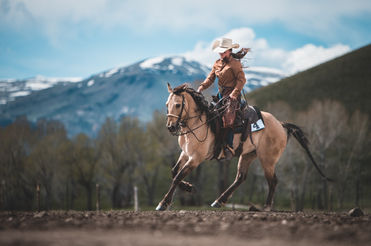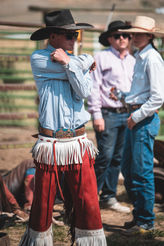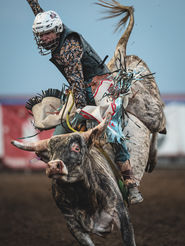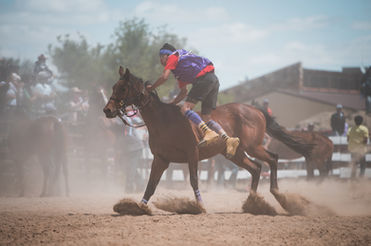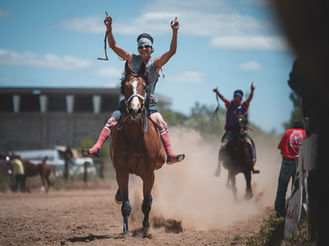

Horsemanship
Horsemanship, the knowledge and skills related to horses and riding, is deeply ingrained in the culture and history of Wyoming. Horses continue to play a vital role on ranches, not only for the practical purposes of working with cattle, but also as a significant aspect of the cultural identity of the people. Besides that, horses take an important stance in rodeo, a sport, which enjoys great popularity particularly in this part of the country, but also in other rural areas in the US. Rodeo grew out of cattle ranching in Mexico and Spain and still has many ranching practices as its central theme. Apart from ranching and rodeo, horses are also used as riding or pack animals in hunting or generally as a recreational activity and tourist attraction. When it comes to the various styles of horsemanship, opinions can vary greatly among horsemen in Wyoming, with the common saying being "ask 10 cowboys and you'll get 11 different answers." This is due in part to the diverse cowboy styles found in Wyoming, including those of the vaquero, buckaroo, and Texas cowpuncher, as well as Indian styles which can be seen in competitions such as the spectacular Indian relay races.
Cowboy Styles
The cowboy is a symbol of the American West, and the image of the rugged, solitary figure on horseback is deeply ingrained in American culture. But beyond this romanticized version, which is often depicted in television, film, and literature, cowboys were and still are real people. Cowboys, as we know them today, have their origins in the practices and traditions of the vaqueros, who were cattle herders and riders in Spanish colonies in South America. These practices and traditions were later brought to the United States, particularly in the late 1700s, when cattle were driven from the southern plains to markets in the north. The term "cowboy" was first used in the late 1700s and early 1800s to describe these cattle drivers. These early cowboys were often young men, many of whom were former slaves, looking for a chance to make a living. The cowboy culture and style of the West have evolved over time and in Wyoming, two different styles of cowboys are still common today: the buckaroo and the Texas cowpuncher. These styles differ primarily in their clothing and riding equipment, as well as the associated riding style. Without going into too much detail, the buckaroo has strong similarities to the vaquero. He can be recognized by his flat-brimmed hat and the use of a hackamore, two reins, or a spade bit. The Texas cowpuncher, on the other hand, typically wears a taco-shaped hat and uses a snaffle bit or curb bit, as well as split reins. The buckaroo uses a closed mecate as reins. The equipment used by cowboys has been shaped primarily by the landscape and unique methods of working cattle. Of course, there are many riders who don't care which category they fit, they are more concerned with having the right kind of horse and gear needed for their method of working cattle. Nevertheless, the following pictures should give a small insight into the different tack used by the riders here.
Rodeo
Rodeo traces its roots back to the practices of the vaqueros, who brought their techniques and traditions from Spanish colonies in South America to the later-formed United States.The word rodeo also comes from Spanish and means to round up. To this day, the sport incorporates various working practices and offers horsemen a chance to demonstrate and compare their skills and those of their horses. Especially in rural Wyoming, the sport enjoys great popularity and rodeos are an integral part of county fairs or special days like Labor Day or National Day of the Cowboy. In Cody, the self-proclaimed "Rodeo Capital of the World," a rodeo is held every evening during the summer months. The "Cody Nite Rodeo", in which mainly amateurs from the region participate to gain experience and earn some extra cash, is mainly attended by tourists. There are various rodeo disciplines, such as bull riding, horseback riding, barrel racing and various roping disciplines. The most common are team roping and breakaway roping. In addition to the professionel rodeo, there is also traditional ranch rodeo. These more local tournaments, in which teams from different ranches compete against each other, include other disciplines that are closer to daily ranch work. For example, riders compete in disciplines such as branding, team penning, trailer loading and wild cow milking.
Bull Riding
Bull riding is typically the main attraction of a rodeo and has become increasingly popular in recent years. There is even a well-produced and recommendable Netflix series about the Professional Bull Riders. The "PBR" is one of the largest bull riding organizations and holds its own tournaments. However, bull riding is also a standard feature at less professional and local rodeos. The sport is extremely dangerous and is performed almost exclusively by men. Only in the case of steer riding, which is intended for children and teenagers, are girls allowed to participate. Steers are less wild and often much smaller, allowing the youngsters to gradually become accustomed to actual bull riding. The goal in bull riding is for the rider, who is allowed to hold onto the bull rope with one hand, to stay on the bull for at least 8 seconds without touching the animal with his free hand. Rides will be scored with a maximum of 100 points. One half of the points reflects the performance of the rider, the other half that of the bull. Only if rider and bull give a proper performance, it is possible to get a high score. In the professional field, the bulls are not just any type of bull, rather they are bred and trained specifically for their use as bucking bulls and the bulls that perform at the big events, like the PBR, can cost several $100,000.
Besides the actual riders, there are a few other important players in bull riding. There is the rodeo clown, the bull fighters as well as the pick up men. The rodeo clown takes on the role of an entertainer, making fun of the riders and getting the crowd fired up. He also helps the bull fighters, if necessary, in their task of protecting the fallen riders from the bulls by drawing attention to themselves. The mounted pick-up men are primarily there to herd the bulls out of the arena if they don't leave on their own.
Indian Relay Race
Indian Relay Races are a type of horse racing popular among Native Americans in the United States that require a high level of skill and athleticism from the riders. The races have been around for centuries and have deep cultural and historical significance for many native communities. The one I attended was part of a powwow in Fort Washakie of the Eastern Shoshone tribe in the Wind River Reservation. The race took place on a circuit and were run at a fast pace, with the riders galloping at full speed. The horses are traditionally ridden bareback, which requires a high degree of balance and skill. A characteristic of Native American relay races is that in some races the riders change horses each lap. This makes the race even more challenging and exciting, as the riders must quickly adapt to the different horses and their individual characteristics. Furthermore it leads to a lot of spectacular scenes and chaos on the track.









